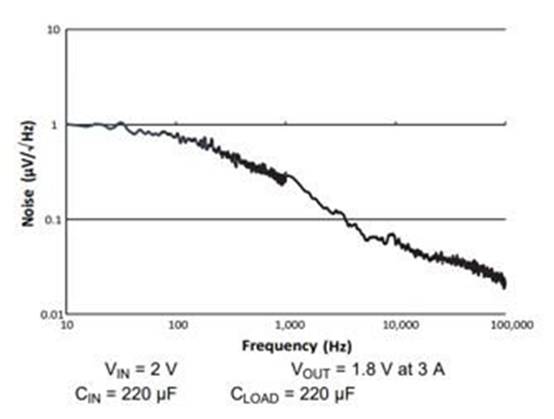How to select the appropriate LDO for satellite applications
Time:2022-10-31
Views:1628
Radiation tolerant low drop voltage regulator (LDO) is an important power supply component for many aerospace level subsystems, including field programmable gate array (FPGA), data converter and analog circuit. LDO helps ensure a stable low noise and low ripple power supply for components whose performance depends on clean inputs.
However, there are so many LDOs in the market, how to select the appropriate radiation resistant devices for the subsystems? Let‘s look at some design specifications and device features to help you make this decision.
Pressure drop of space LDO
The voltage drop of LDO is the voltage difference between the input voltage and the output voltage, under which the LDO stops adjusting the output voltage. The smaller the voltage drop specification is, the smaller the working voltage difference can be achieved, so that the power dissipation and heat dissipation are less, and the maximum efficiency is essentially improved. These advantages will become more significant at higher currents, as shown in Formula 1:
LDO power dissipation=(VIN - VOUT) x IOUT (1)
In terms of radiation resistance, it is difficult to find a real low dropout regulator that provides strong performance in terms of radiation, temperature and aging. For example, TI‘s radiation resistant LDO TPS7H1101A-SP can provide a typical voltage drop (Vdo) of 210mV at 3A current, which is currently at an ultra-low level in the market. If you have a standard 5V, 3.3V, 2.5V or 1.8V power rail available, the LDO can adjust the output voltage to 0.8V to provide any required voltage and current required by one or more aerospace level analog-to-digital converters (ADC) or clocks.
Noise performance of aerospace LDO
With satellites operating in space for 10 years or more, it is helpful to ensure the design life to give full play to the performance of airborne integrated circuits. In order to provide clean and low-noise power rails for high-performance clocks, data converters, digital signal processors or analog components, LDO circuits need to generate ultra-small internal noise. Since it is not easy to filter the 1/f noise generated internally, LDO with inherent low noise characteristics should be used. Low frequency noise is usually the largest and most difficult to filter. TPS7H1101A-SP provides an ultra-low 1/f noise level, with a peak value of about 1 µ V/√ Hz at 10Hz. See Figure 1 below for RMS noise variation with frequency.


Figure 1: TPS7H1101A-SP Noise
PSRR of space LDO
Power supply rejection ratio (PSRR) is used to measure the ability of LDO to eliminate or suppress the noise introduced by other upstream components. For high-end ADC, in order to reduce bit errors to a greater extent, the requirements for input power noise are constantly improving. Due to the characteristics of the control loop, it is difficult to obtain high PSRR at high frequencies. In general, designers need to use external components to filter noise to achieve an acceptable and effective PSRR, but this will increase the size of the solution - this is an obvious problem for aerospace applications, because size and weight will directly affect the cost of satellite launch. At the switching frequency of the upstream power supply, special attention should be paid to PSRR (because there is voltage ripple at this frequency). In addition, due to the influence of switching harmonics, PSRR should also be properly considered at this frequency. If you expect to achieve excellent PSRR, TPS7A4501-SP LDO can provide more than 45dB of PSRR at 100kHz.
Other important LDO characteristics
In addition to voltage drop, PSRR and noise, let‘s look at several outstanding features that are indispensable for achieving radiation resistant LDO performance.
Enable. In space, solar panels can only provide a certain amount of electrical energy, and many functions depend on electrical energy to run. With the enable feature, you can specify whether the LDO is on or off at any given time, which has proven to be critical to saving the overall power budget. Enabling pins are also important for power on timing, and the demand for power on timing of the new generation FPGA is growing.
Soft start. Too fast voltage rise may cause current overshoot or excessive peak surge current, thus damaging FPGA or ADC and other downstream devices. The soft start feature can adjust the speed of output voltage rise during startup. Soft start can also prevent the upstream power supply from generating overcurrent, thus preventing unacceptable voltage drop.
Output voltage accuracy. Generally, newer aerospace grade FPGAs such as Xilinx KU060 have strict input voltage tolerance requirements for each power rail to achieve optimal performance. To ensure that your design meets strict accuracy requirements under radiation exposure and end of life conditions, please use TPS7H1101A-SP and other devices, which are located on the KU060 development board.
Dimensions. In addition to using small packages that are easy to layout, other ways to reduce the size of the solution include limiting the number of external components of LDOs, achieving more integrated functions, better PSRR and noise specifications, and achieving more reliable radiation resistance under the single particle effect. TI‘s TPS7A4501-SP is an ultra small radiation resistant LDO in the industry in terms of package size, layout and solution size.
epilogue
In the face of so many devices, it may be difficult to select a suitable LDO, and the most important functions and characteristics should be considered. For example, if your application is to power high-end FPGAs or high-speed data converters, the characteristics of output voltage accuracy, reference accuracy, PSRR and noise may be the priority factors. However, if you want to design a low performance analog circuit or use an old FPGA with less strict tolerance requirements, it may be a better choice to have an ultra small and low-cost solution while maintaining proper functions.
|
Disclaimer: This article is transferred from other platforms and does not represent the views and positions of this site. If there is any infringement or objection, please contact us to delete it. thank you! |











